The Recruiter's Guide to LinkedIn Publishing and Pulse
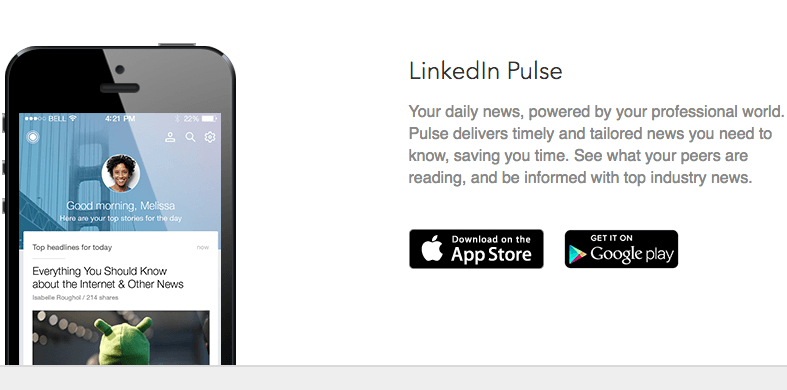
If you are a frequent user of LinkedIn, you will have probably come across the LinkedIn Publishing Platform and the Pulse product. LinkedIn’s Publishing Platform enables members to share content (think blog posts) with their professional connections. The most popular and engaging posts are featured on Pulse, which is an online news aggregation feed designed for members to keep up to date with the latest trends and follow specific influencers, channels and publishers. Getting posts featured on Pulse is considered the holy grail as it greatly increases the exposure of your content.
It’s pretty obvious by now that LinkedIn has a heavy focus on serving content in order to make users stay on site, which is why anyone on the network can now publish content. As a result, content consumption on LinkedIn has increased by 21% in the last 2 years. This means there are big opportunities for recruitment teams to take advantage of the obvious benefits provided by this channel such as expansion of reach, amplifying their employer brand, increasing thought leadership and connecting with potential candidates. With that being said, many recruiters have still remained on the sidelines. So today we’re going to break down the benefits of LinkedIn Publishing and the best way for companies to use this platform for their recruitment strategies (and hopefully get featured on Pulse!)
Benefits of Publishing
If you follow this blog regularly, you’ll know that we believe that recruitment and marketing have become fully intertwined. And the marketing potential of LinkedIn Publishing has remained largely untapped. So before jumping right in to the nitty-gritty of the best way to use the this platform, we should quickly explore the main benefits it offers if you use it properly.
A Built-In Audience
When you publish a blog on your website, readership is limited to website visitors, email subscribers and social media followers. The great thing about LinkedIn Publishing is that every time you hit that ‘Publish’ button, a significant amount of your LinkedIn connections get a notification saying you just published an post. Not only this but the post immediately registers in your followers’ news feeds which increases exposure. Lost communication with potential candidates on LinkedIn? This is a great way for you to pop up in their notifications and stay top of mind.
Be careful though – LinkedIn use an algorithm to determine which notifications get seen by whom in order to avoid spamming so be sure to provide high-quality articles (more on this later).
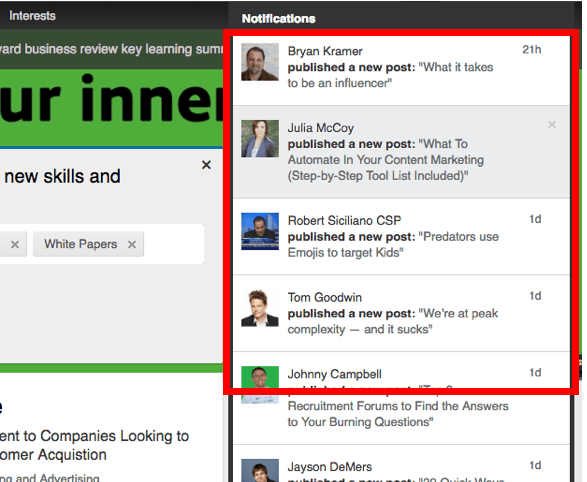
Search Engine Optimisation
LinkedIn is one of the top 20 most high-traffic sites on the web. Because LinkedIn has high authority, Google is more likely to index content from this site and include your published posts in the search engine results pages. This can help teams and companies build authority and increase the visibility of their content. So essentially what we’re saying is that if your company website generally doesn’t feature highly in search results, LinkedIn Publishing is a great platform to overcome this.
Access to Industry Influencers
By regularly publishing your content and engaging with other writers, you can create access for yourself to connect with key influencers. There are a myriad of definitions of an influencer but look out for other users who get the most views and engagement on their content. Regularly commenting, liking and and sharing their articles will put you and your company on their radar.
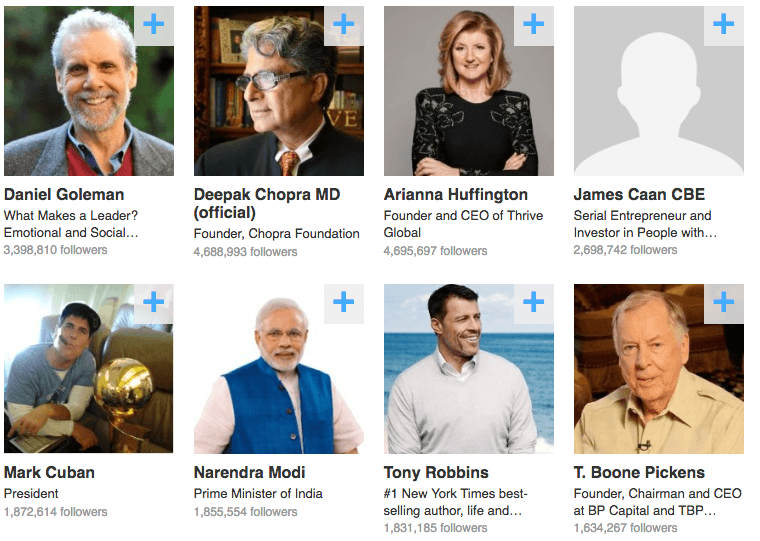
Examples of Pulse Influencers
Targeted Content
Any content you publish will hit the LinkedIn news feed; then most of your connections will be notified and the post will also display on your profile. But if your article is in the small percentage that gets selected and featured in Pulse channels/categories (discussed more later), it can potentially get read by thousands of users who are interested in the specific topic you are writing about.
[cta-blog]
How To Get Started
Now that you are familiar with LinkedIn Publishing and the potential benefits it has to offer, it’s time to get started. We’ll break down the approach you should take to Publishing into ‘pre-publish tasks’, creating and designing the post itself and ‘post-publish tasks’. This will act as your go-to-guide when you’re thinking about incorporating this channel into your recruitment strategy.
Pre-Publish Tasks
Determine What Content Works
First things first, you need to decide on the content topics you are going to write about. Companies not only think have to think about what they want to achieve with their content (e.g. employer branding goals) but they should also actively research trending topics and points of interest. A simple scan through the trending topics in the Pulse news feed will give you a good indication of what resonates with audiences the most.
Corey Wainwright, Director of Content at Hubspot, provided some valuable insight when she found the top 20 performing featured posts on Pulse. Most cover tips on how professionals can improve e.g. best practices for hiring & interviewing, marketing processes and productivity. With this insight, our suggestion would be to take this a step further and drill down into the trending topics within specific Pulse channels. Being part of a recruitment team, there are a myriad of channels that should be of interest including ‘Recruiting & Hiring‘, ‘Your Career‘, ‘Millennials‘, ‘Company Culture‘ and many more.
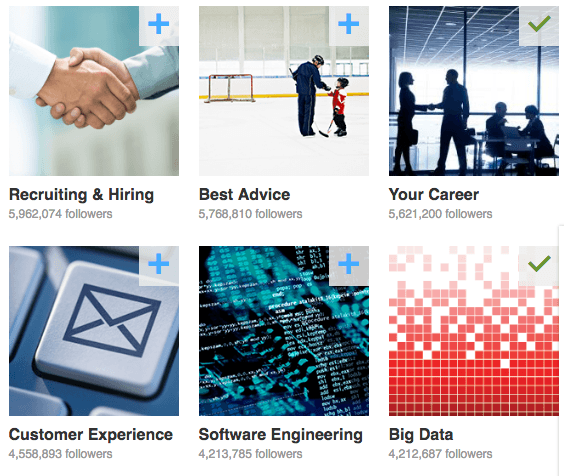
LinkedIn Pulse Channels
Build a Valuable Network
More so an ongoing activity you should be doing than a pre-publishing task but if your connection count is pretty low before you publish, you and your team should make a concerted effort to build a more healthy and quality following. As we mentioned previously, you have a built-in audience who receive notifications every time you publish so it’s in your best interests to increase your connections. You don’t have to do anything groundbreaking here; simple things like posting a LinkedIn status every day, engaging with your connections’ updates and adding your LinkedIn URL to your email signature are quick ways to grow your LinkedIn network.
Another way to grow your network is through LinkedIn Groups. Groups are one of the features on LinkedIn that aren’t used enough by recruitment teams. They are a great place for recruiters to share content, have discussions, make meaningful connections and establish themselves as thought leaders. There are thousands of LinkedIn groups dedicated to HR and recruitment; these are 10 LinkedIn Groups we think you should join to get yourself started.
A handy little feature that you can also use is the ‘My Network’ tab when logged into your account. From here, select ‘Add Contacts’ and you will be directed to a page where you can find potential connections by importing contacts from your email accounts.
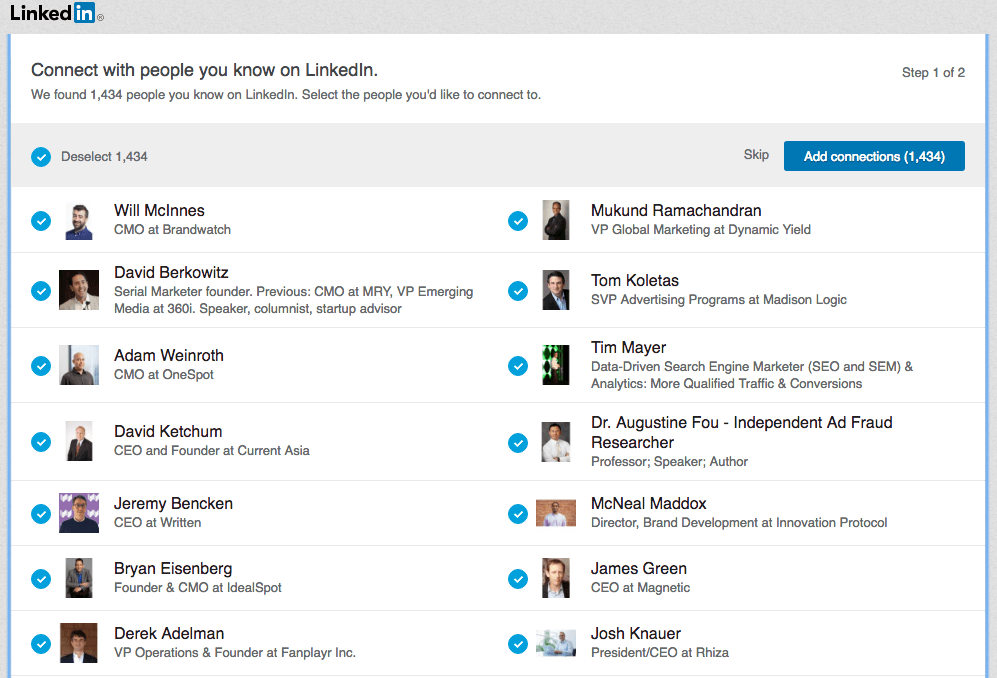
Creating and Designing Your Post
Structure
You are competing with 130,000 other LinkedIn posts every week. So in order to break away from the noise, you need to develop the ability to publish content that appeals to your target audiences. At this stage, you should have a list of content topics based on your research of the various Pulse channels relevant to you.
The next step is to craft your headline which is critical in capturing your audience’s attention. Generally, ‘how-to’ and list type posts perform best in terms of views, likes and shares. Examples of these types of posts include:
How the Companies that Everyone Wants to Work for Recruit Their Employees
10 Things You Should Never Put in Your inMails…Like Ever
If you’re struggling to create an attention-grabbing headline, you can test it on the Headline Analyzer tool provided by CoSchedule which scores your overall headline quality and rates its ability to result in social shares, increases in traffic and SEO value. Throughout the post, add headings and subheadings to break up the text and try to aim for over 1,000 words. Posts with large word counts typically perform best.
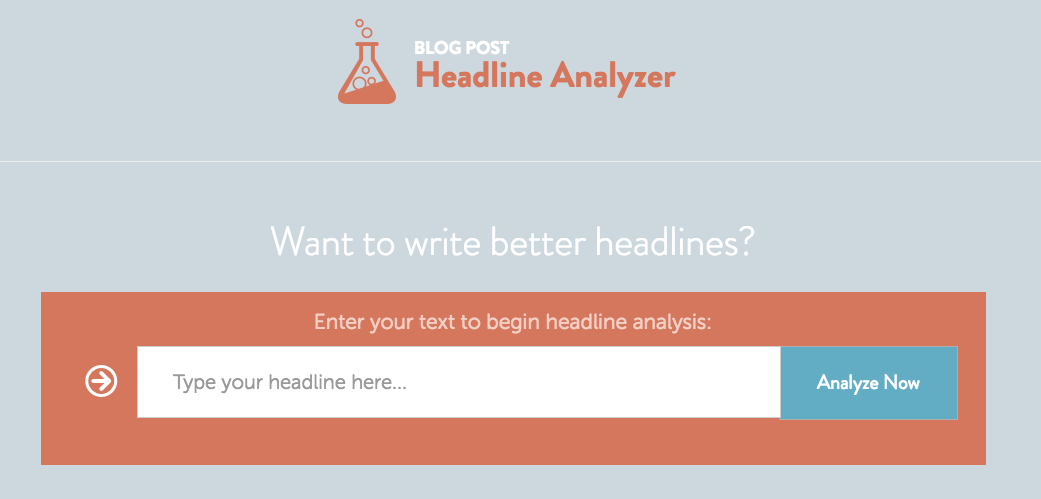
Rich Media
We said it before and we’ll say it again; the attention span of users is at an all-time low so it’s important to use rich media throughout your LinkedIn posts. The great thing about LinkedIn Publisher is they support all sorts of media, including YouTube & Vimeo videos, SlideShare presentations and URLs. Your LinkedIn Pulse posts appear in user news feeds so it’s important to post some eye-catching visuals to help your update stand out from the clutter.
Tags
You’ve created your Pulse post which is filled with valuable, informative and engaging content – great! Now it’s time to hit that ‘Publish’ button. Don’t worry, it won’t publish right there and then. You will be prompted first to add a blurb for your post where you will also be encouraged to add tags. Why are tags useful? Well adding tags to your posts can help them get found by readers in your target audience.
For example, users can look for tags in the their search bars to find content relevant to them (tags are searchable on mobile and are coming to desktop very soon). Not only that but LinkedIn have a tagging algorithm which determines which Pulse channels a post belongs in (if selected to be featured). The content in the post itself is evaluated rather than the user profile so every member sees customised professional news and insights.
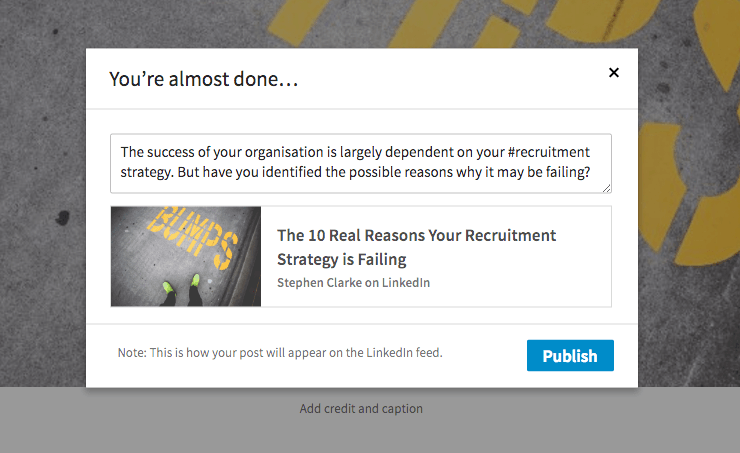
Post-Publish Tasks
Now it’s time to hit that ‘Publish’ button again and voilà, your post is in the LinkedIn ecosystem! But it would be negligent to stop the process here. You need to make sure that your content gets seen by as many eyeballs as possible.
Promotion
Once you publish your post, you are given the option to cross-promote your content on other social networking sites, Facebook and Twitter. Don’t skip this option – it’s a great opportunity for you to promote this content on other platforms whether it be your personal or company profiles. This will help increase your audience reach.
A bonus tip comes from Daniel Roth, Executive Editor at LinkedIn, where he says you can notify the LinkedIn team on Twitter when you share your post on the network. All you have to do is add “tip @linkedinpulse” in your Tweet. This will increase your chances of getting featured in one of the Pulse channels as the Tweet will automatically flag your post for review.
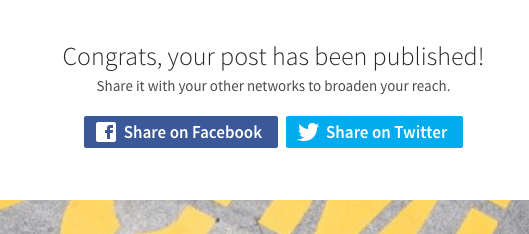
Engage with Commenters and Sharers
If your post is valuable, it’s likely to spark interest and further conversation which generally occurs in the ‘Comments’ section and through re-shares. Unfortunately, many authors seem to forget that a post is the start of the conversation and never return to engage. Audience interaction greatly contributes to the likelihood of the post getting featured in one of the Pulse channels. That being said, responding and interacting with followers will help build a rapport with them anyway so even if your posts don’t get featured, you will have started the process of building a loyal following.
Consistency and Frequency are Key
The same concept applies to blogging; the more often you publish on LinkedIn, the more likely you will be found. You’re not going to see amazing results after a couple of posts so make sure you and your team are committed to a publishing schedule. It depends on the size of your team but each individual should try to commit to do at least one post per week. Increasing your visibility like this will help grow your company presence and influence.
Again, not all of your articles are going to do well and feature in Pulse but if you publish regularly and consistently, this will help you build a following that views, engages and shares your content. If you’re wondering about the best times to publish, LinkedIn reports highest traffic occurs between morning and midday, Monday-Friday. Paul Shapiro, Director of Search Innovation at GroupM, took this a step further and found that the best day to publish is on Thursday as posts on this day get the most views.
To Recap
LinkedIn has opened the floodgates for content writers to publish on their platform and it’s a great way for recruiters and companies to increase the exposure of their content on the largest professional network in the world. The benefits of the LinkedIn Publishing are unrivalled as you already have a built-in audience and you get immediate access to industry influencers. Basically, it’s another channel for recruiters to amplify their employer brand and increase their company visibility.
But that doesn’t mean a lot of effort doesn’t have to go in to the platform. Much like blogging, posts need to be optimised so they get seen by the right audience. It may take a while to get featured into those Pulse channels but if you write quality content on a regular basis and follow the steps above, you will greatly increase your chances in doing so.
